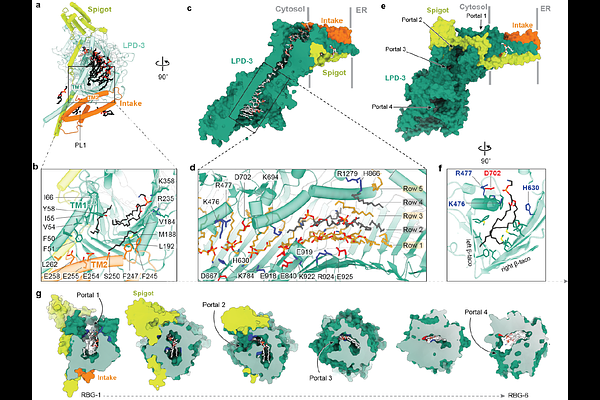Structural basis of bulk lipid transfer by bridge-like lipid transfer protein LPD-3

Structural basis of bulk lipid transfer by bridge-like lipid transfer protein LPD-3
Kang, Y.; Lehmann, K. S.; Vanegas, J.; Long, H.; Jefferson, A.; Freeman, M. A.; Clark, S.
AbstractBridge-like lipid transport proteins (BLTPs) are an evolutionarily conserved family of proteins that localize to membrane contact sites and are thought to mediate the bulk transfer of lipids from a donor membrane, typically the endoplasmic reticulum (ER), to an acceptor membrane, such as a that of the cell or an organelle. Despite the fundamental importance of BLTPs for cellular function, the architecture, composition, and lipid transfer mechanisms remain poorly characterized. Here, we present the subunit composition and the cryo-electron microscopy structure of the native LPD-3 BLTP complex isolated from transgenic C. elegans. LPD-3 folds into an elongated, rod-shaped tunnel whose interior is filled with ordered lipid molecules that are coordinated by a track of ionizable residues that line one side of the tunnel. LPD-3 forms a complex with two previously uncharacterized proteins, here named Intake and Spigot, both of which interact with the N-terminal end of LPD-3 where lipids enter the tunnel. Intake has three transmembrane helices, one of which borders the entrance to the tunnel; Spigot has one transmembrane helix and extends 80 angstroms along the cytosolic surface of LPD-3. Experiments in multiple model systems indicate that Spigot plays a conserved role in ER-PM contact site formation. Our LPD-3 complex structural data, together with molecular dynamics simulations of the transmembrane region in a lipid bilayer, reveal protein-lipid interactions that suggest a model for how the native LPD-3-complex mediates bulk lipid transport and provide a foundation for mechanistic studies of BLTPs.